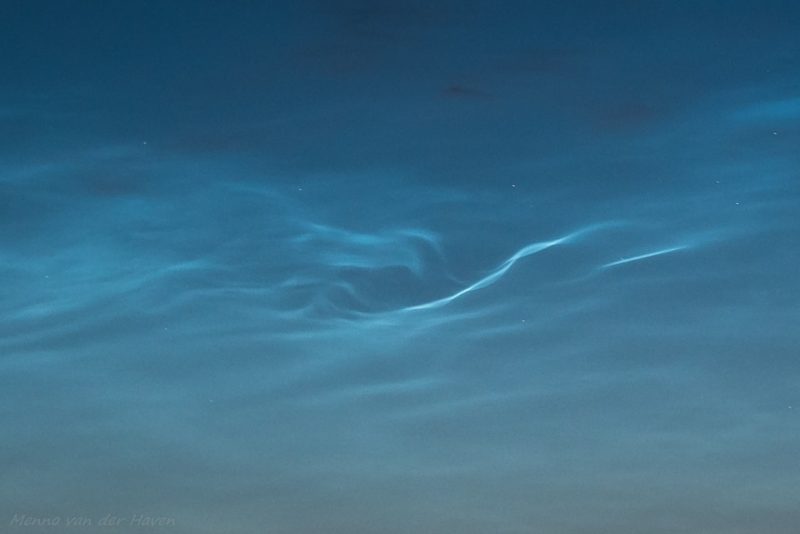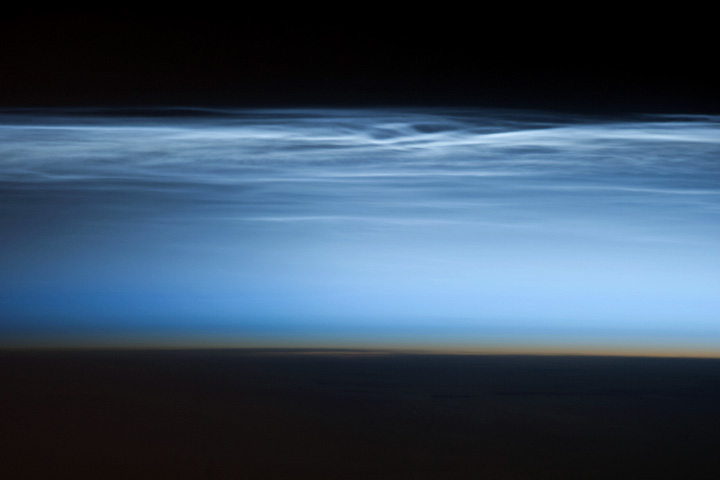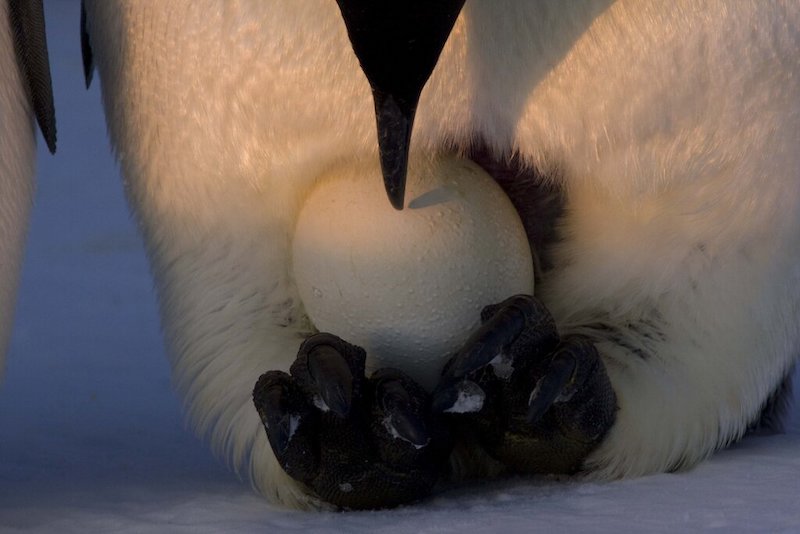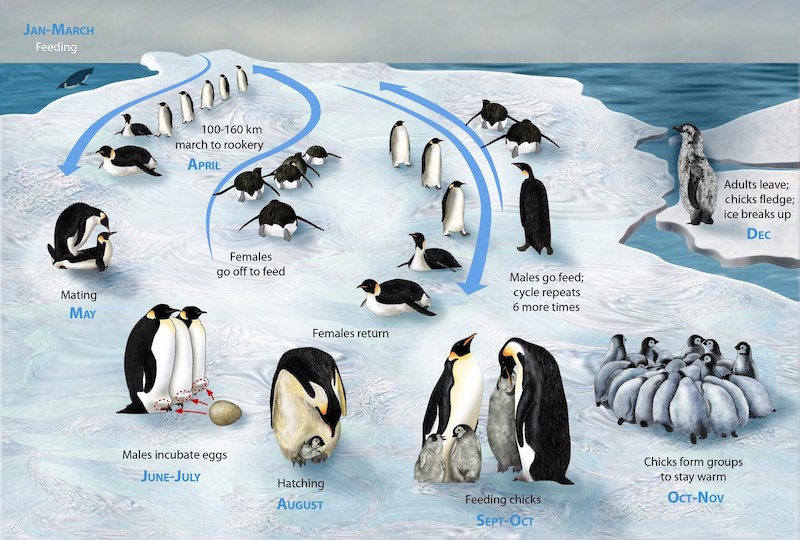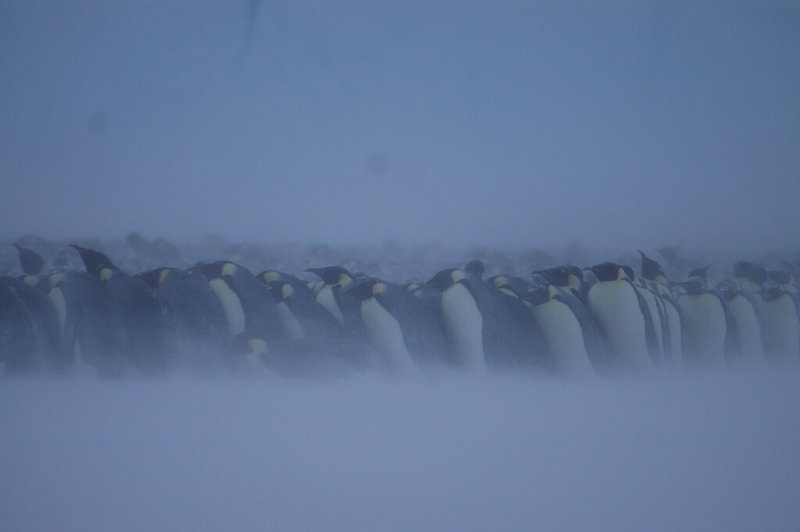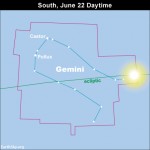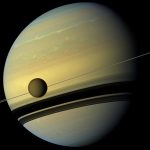

Titan orbiting Saturn, as seen by the Cassini spacecraft on May 12, 2012. Image via NASA/ JPL-Caltech/ Space Science Institute.
Researchers knew Saturn’s moon, Titan, was moving away from its planet, just as Earth’s moon gradually orbits farther from Earth. But – while Titan’s outward drift is still extremely slow – this large moon is now known to be moving away from Saturn 100 times faster than previously thought. That’s according to a June 2020 announcement by scientists in the U.S., France and Italy.
The peer-reviewed findings were published on June 8 in the journal Nature Astronomy.
The rate of Titan’s movement away from Saturn had been thought to be well understood, but as often happens in science, a new discovery has upended that idea. The discovery was made via a new analysis of data from the Cassini spacecraft, which orbited Saturn from 2004 to 2017. The data show Titan moving outward at about 4 inches (11 centimeters) per year.
That might not sound like a lot, but it’s significantly faster than the rate at which our moon drifts away from Earth. Our moon is drifting outward at only about 1.5 inches (3.8 centimeters) each year.
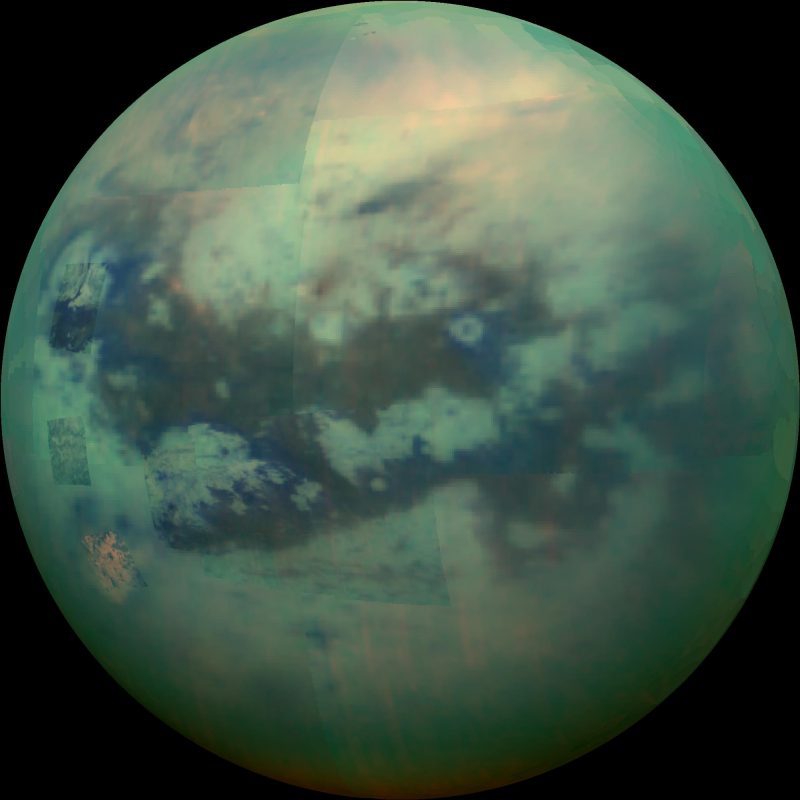
Titan’s surface as seen in infrared via Cassini on November 13, 2015. Titan is completely surrounded by thick haze, but Cassini’s radar penetrated the haze to reveal surface details. Image via NASA/ JPL/ University of Arizona/ University of Idaho.
The researchers reached this conclusion after studying images of stars sent back by Cassini. They mapped the background stars and tracked the position of Titan among them. Those images were then compared to a completely separate dataset, Cassini’s radio science data. Cassini sent radio waves back to Earth during 10 close flybys that the spacecraft conducted of Titan between 2006 and 2016. By examining how the frequency of the radio signals was affected by interactions with its environment in space, the researchers could estimate how Titan’s orbit evolved and changed over the past few billion years. Study coauthor Paolo Tortora, of Italy’s University of Bologna, explained in a statement:
By using two completely different datasets, we obtained results that are in full agreement, and also in agreement with Jim Fuller’s theory, which predicted a much faster migration of Titan.
Why do moons move away from their planets, anyway?
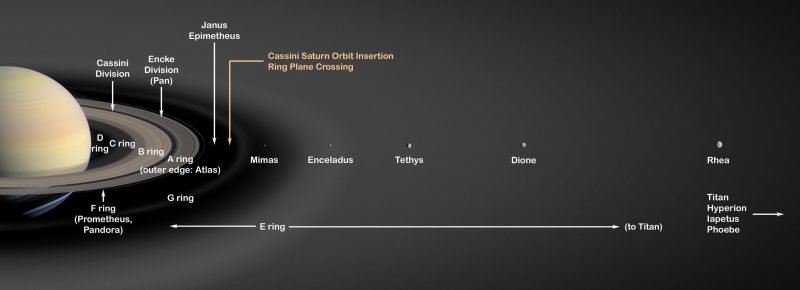
Titan is one of the outer moons of Saturn, orbiting well beyond the main rings and out past Rhea. Image via NASA/ JPL/ Wikipedia.
As a moon orbits a planet, its gravity tugs a bit on the planet – a process called tidal friction – creating strain and a resulting very slight bulge on the planet. On Earth, this bulge happens most noticably in our oceans – called a tidal bulge – and causes the cycle of high and low tides, but planets without oceans can bulge, too. This cyclic process of bulging and then subsequent relaxing creates a lot of energy over a long period of time. Tidal friction, however, also prevents the tidal bulge on Earth from remaining directly beneath the moon; instead it is carried along with the rotation of the Earth. The energy, created by mutual attraction between the moon and the material in the bulge, accelerates the moon slightly in its orbit. This causes the moon to drift a tiny bit farther away from Earth over time.
The new result also has implications for the age of the entire Saturn system. It’s still uncertain just how old Saturn’s rings are, as well as the planet’s moons. Right now, Titan is 759,000 miles (1.2 million kilometers) from Saturn; if the new measurement of the moon’s drift rate is correct, it means that Titan must have once been closer to Saturn than previously understood, and that Titan has migrated to its current position far out from the planet. In other words, Titan must have gone from being an inner moon to being an outer moon.
The new result further implies that the entire Saturn system of moons expanded faster than thought. Valery Lainey, lead author of the new study, formerly a scientist at the Jet Propulsion Laboratory (JPL) and now at the Paris Observatory at PSL University, stated:
This result brings an important new piece of the puzzle for the highly debated question of the age of the Saturn system and how its moons formed.
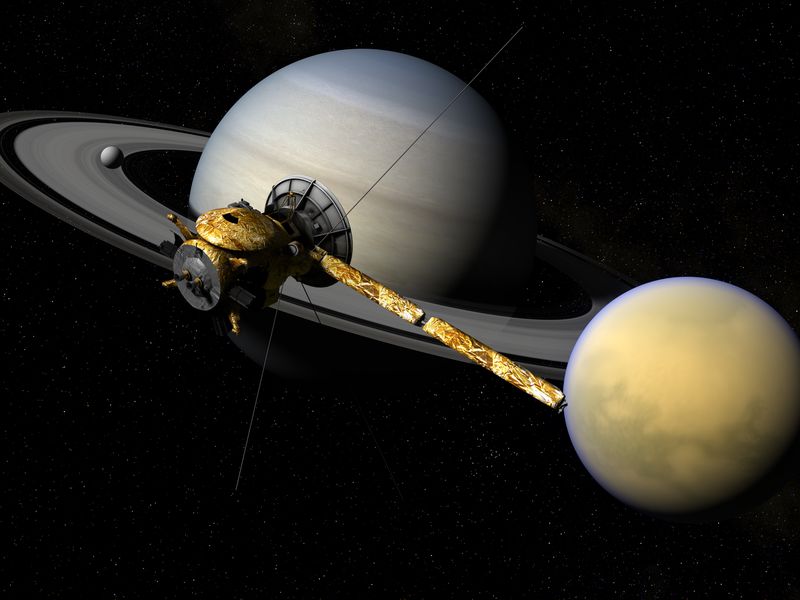
Artist’s concept of Cassini near Titan. Image via Kevin Gill/ Flickr/ Smithsonian Magazine.
Plus, the findings offer validation for a theory about how planets affect the orbits of their moons. Previous theories have stated that moons farther out from a planet migrate more slowly than moons closer in. The assumption was that the planet’s gravity would have a greater affect on moons that were closer, which sounds logical. But that view came into dispute four years ago, thanks to theoretical astrophysicist Jim Fuller at Caltech. He predicted that outer moons and inner moons should actually migrate at similar rates, because outer moons have a different orbit pattern linked to the “wobble” of a planet. That wobble can sling inner moons outward. Fuller said:
The new measurements imply that these kind of planet-moon interactions can be more prominent than prior expectations and that they can apply to many systems, such as other planetary moon systems, exoplanets – those outside our solar system – and even binary star systems, where stars orbit each other.

Valery Lainey at JPL and the Paris Observatory, lead author of the new study. Image via ResearchGate.
Cassini orbited Saturn for more than 13 years, collecting vast amounts of data and taking thousands of images. The mission ended in September 2017 after the spacecraft finally ran out of fuel. By design, Cassini plummeted into Saturn’s deep, tumultuous clouds to burn up so as to not risk contaminating any of the moons, especially Enceladus or Titan, with any stray microbes from Earth that may have still been onboard. Cassini revolutionized our knowledge about the Saturn system, and as this study shows, there is still much to learn.
Bottom line: New study shows that Titan is moving away from Saturn 100 times faster than first thought.
Source: Resonance locking in giant planets indicated by the rapid orbital expansion of Titan
from EarthSky https://ift.tt/3dujkPS


Titan orbiting Saturn, as seen by the Cassini spacecraft on May 12, 2012. Image via NASA/ JPL-Caltech/ Space Science Institute.
Researchers knew Saturn’s moon, Titan, was moving away from its planet, just as Earth’s moon gradually orbits farther from Earth. But – while Titan’s outward drift is still extremely slow – this large moon is now known to be moving away from Saturn 100 times faster than previously thought. That’s according to a June 2020 announcement by scientists in the U.S., France and Italy.
The peer-reviewed findings were published on June 8 in the journal Nature Astronomy.
The rate of Titan’s movement away from Saturn had been thought to be well understood, but as often happens in science, a new discovery has upended that idea. The discovery was made via a new analysis of data from the Cassini spacecraft, which orbited Saturn from 2004 to 2017. The data show Titan moving outward at about 4 inches (11 centimeters) per year.
That might not sound like a lot, but it’s significantly faster than the rate at which our moon drifts away from Earth. Our moon is drifting outward at only about 1.5 inches (3.8 centimeters) each year.

Titan’s surface as seen in infrared via Cassini on November 13, 2015. Titan is completely surrounded by thick haze, but Cassini’s radar penetrated the haze to reveal surface details. Image via NASA/ JPL/ University of Arizona/ University of Idaho.
The researchers reached this conclusion after studying images of stars sent back by Cassini. They mapped the background stars and tracked the position of Titan among them. Those images were then compared to a completely separate dataset, Cassini’s radio science data. Cassini sent radio waves back to Earth during 10 close flybys that the spacecraft conducted of Titan between 2006 and 2016. By examining how the frequency of the radio signals was affected by interactions with its environment in space, the researchers could estimate how Titan’s orbit evolved and changed over the past few billion years. Study coauthor Paolo Tortora, of Italy’s University of Bologna, explained in a statement:
By using two completely different datasets, we obtained results that are in full agreement, and also in agreement with Jim Fuller’s theory, which predicted a much faster migration of Titan.
Why do moons move away from their planets, anyway?

Titan is one of the outer moons of Saturn, orbiting well beyond the main rings and out past Rhea. Image via NASA/ JPL/ Wikipedia.
As a moon orbits a planet, its gravity tugs a bit on the planet – a process called tidal friction – creating strain and a resulting very slight bulge on the planet. On Earth, this bulge happens most noticably in our oceans – called a tidal bulge – and causes the cycle of high and low tides, but planets without oceans can bulge, too. This cyclic process of bulging and then subsequent relaxing creates a lot of energy over a long period of time. Tidal friction, however, also prevents the tidal bulge on Earth from remaining directly beneath the moon; instead it is carried along with the rotation of the Earth. The energy, created by mutual attraction between the moon and the material in the bulge, accelerates the moon slightly in its orbit. This causes the moon to drift a tiny bit farther away from Earth over time.
The new result also has implications for the age of the entire Saturn system. It’s still uncertain just how old Saturn’s rings are, as well as the planet’s moons. Right now, Titan is 759,000 miles (1.2 million kilometers) from Saturn; if the new measurement of the moon’s drift rate is correct, it means that Titan must have once been closer to Saturn than previously understood, and that Titan has migrated to its current position far out from the planet. In other words, Titan must have gone from being an inner moon to being an outer moon.
The new result further implies that the entire Saturn system of moons expanded faster than thought. Valery Lainey, lead author of the new study, formerly a scientist at the Jet Propulsion Laboratory (JPL) and now at the Paris Observatory at PSL University, stated:
This result brings an important new piece of the puzzle for the highly debated question of the age of the Saturn system and how its moons formed.

Artist’s concept of Cassini near Titan. Image via Kevin Gill/ Flickr/ Smithsonian Magazine.
Plus, the findings offer validation for a theory about how planets affect the orbits of their moons. Previous theories have stated that moons farther out from a planet migrate more slowly than moons closer in. The assumption was that the planet’s gravity would have a greater affect on moons that were closer, which sounds logical. But that view came into dispute four years ago, thanks to theoretical astrophysicist Jim Fuller at Caltech. He predicted that outer moons and inner moons should actually migrate at similar rates, because outer moons have a different orbit pattern linked to the “wobble” of a planet. That wobble can sling inner moons outward. Fuller said:
The new measurements imply that these kind of planet-moon interactions can be more prominent than prior expectations and that they can apply to many systems, such as other planetary moon systems, exoplanets – those outside our solar system – and even binary star systems, where stars orbit each other.

Valery Lainey at JPL and the Paris Observatory, lead author of the new study. Image via ResearchGate.
Cassini orbited Saturn for more than 13 years, collecting vast amounts of data and taking thousands of images. The mission ended in September 2017 after the spacecraft finally ran out of fuel. By design, Cassini plummeted into Saturn’s deep, tumultuous clouds to burn up so as to not risk contaminating any of the moons, especially Enceladus or Titan, with any stray microbes from Earth that may have still been onboard. Cassini revolutionized our knowledge about the Saturn system, and as this study shows, there is still much to learn.
Bottom line: New study shows that Titan is moving away from Saturn 100 times faster than first thought.
Source: Resonance locking in giant planets indicated by the rapid orbital expansion of Titan
from EarthSky https://ift.tt/3dujkPS



